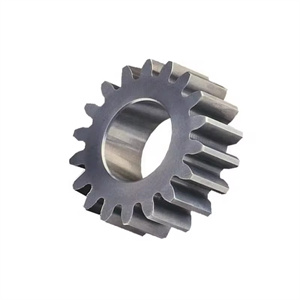Machining the production of steel spur gears is a precise and critical manufacturing process. Steel spur gears play an important transmission role in many mechanical devices, such as industrial machinery, automotive transmissions, etc. Firstly, in terms of materials, high-quality carbon structural steel (such as 45 steel) or alloy structural steel (such as 20CrMnTi) is generally selected to ensure that the gears have sufficient strength and wear resistance. For the manufacturing of blanks, common methods include forging and casting. Forging can improve the internal structure of steel and enhance its mechanical properties; Casting is suitable for production with complex shapes and large batches.
In the tooth profile machining process, the main processes include:
Gear hobbing: Using a gear hobbing machine and a hob, the tooth shape is cut by the generation method. This is an efficient and high-precision processing method suitable for large-scale production. During the gear hobbing process, it is necessary to accurately control the relative motion between the hob and the workpiece, as well as the parameters and installation accuracy of the hob.
Gear shaping: For some special shaped or small-sized steel spur gears, gear shaping technology may be used. The gear shaping machine gradually forms a tooth shape through the reciprocating motion of the gear shaping cutter.
In machining, multiple cutting and measurement adjustments are carried out to ensure the accuracy of tooth profile and the uniformity of tooth pitch. For example, in the machining of steel spur gears used in automotive transmissions, high requirements are placed on the roughness and contact accuracy of the tooth surface, requiring precise process control. After completing the tooth profile machining, heat treatment is usually carried out, such as quenching, tempering, etc., to increase the hardness and toughness of the gear. Subsequently, precision machining processes such as gear grinding may be carried out to further improve the accuracy and surface quality of the tooth surface.
Customizing gears typically involves multiple steps and factors to ensure that the final product meets specific requirements and specifications. The following is the general gear customization process:
Determine requirements: Firstly, it is necessary to clarify key parameters such as the usage scenario, working environment, load requirements, and speed of the gear. These parameters will directly affect the material selection, size design, accuracy requirements, and other aspects of gears.
Material selection: Select suitable gear materials based on the usage environment and requirements. Common gear materials include carbon steel, alloy steel, stainless steel, cast iron, etc. The selection of materials will directly affect the strength, wear resistance, corrosion resistance, and other properties of gears.
Design and drafting: Determine the basic parameters such as tooth number, modulus, and pressure angle of the gear according to the requirements, and use CAD and other drawing software to design and draw the gear. During this process, factors such as gear ratio, transmission efficiency, and noise need to be considered.
Manufacturing and processing: Select appropriate manufacturing and processing methods based on design drawings. Common gear processing methods include gear hobbing, gear shaping, gear milling, etc. Strict control of precision and quality is required during the machining process to ensure the performance and lifespan of gears.
Inspection and testing: After manufacturing is completed, the gears need to be inspected and tested. This includes gear size measurement, accuracy testing, noise testing, etc. Only through strict inspection and testing can the quality and performance of gears meet the requirements.
Customized packaging and shipping: Based on customer needs, customize packaging for gears and arrange for shipping. Before shipping, it is necessary to double check the quality and quantity of the gears to ensure that customers receive satisfactory products.
